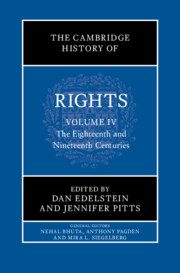Book contents
- the cambridge history of rights
- The Cambridge History of Rights
- The Cambridge History of Rights
- Copyright page
- Contents
- Figures
- Contributors to Volume IV
- General Introduction
- A Note on Translations
- Introduction to Volume IV
- Part I A Revolution in Rights?
- Part II Postrevolutionary Rights
- Part III Rights and Empires
- 18 Rights and Empires
- 19 Rights in Late Mughal and Early Colonial India
- 20 Rights in the Americas
- 21 The Free Sea
- 22 Abolition and Imperialism in Africa
- 23 Rights in Pan-Asian, Pan-Islamic, and Pan-African Thought
- 24 Indigenous Rights in Settler Colonies
- 25 Catholicism and Rights
- 26 (Human) Rights Associations (1775–1898)
- Index
- References
26 - (Human) Rights Associations (1775–1898)
from Part III - Rights and Empires
Published online by Cambridge University Press: 22 January 2025
- the cambridge history of rights
- The Cambridge History of Rights
- The Cambridge History of Rights
- Copyright page
- Contents
- Figures
- Contributors to Volume IV
- General Introduction
- A Note on Translations
- Introduction to Volume IV
- Part I A Revolution in Rights?
- Part II Postrevolutionary Rights
- Part III Rights and Empires
- 18 Rights and Empires
- 19 Rights in Late Mughal and Early Colonial India
- 20 Rights in the Americas
- 21 The Free Sea
- 22 Abolition and Imperialism in Africa
- 23 Rights in Pan-Asian, Pan-Islamic, and Pan-African Thought
- 24 Indigenous Rights in Settler Colonies
- 25 Catholicism and Rights
- 26 (Human) Rights Associations (1775–1898)
- Index
- References
Summary
Noting the proliferation of human rights leagues at the turn of the twentieth century, and their significance up to the interwar period, this chapter argues that such leagues built on an organizational and discursive repertoire built over the course of the prior century by three transnational movements above all: the abolitionist, women’s suffrage, and peace movements. These movements shared a recognition of a systemic link between the rule of law, humanitarianism, and political participation by the people, and they sought to realize these connected values through new forms of association and mobilization. These movements shared some personnel, organizing strategies, and rhetoric. Although the language of rights and more particularly “human rights” or “droits de l’homme” was relatively marginal to these movements, especially outside France, their members did invoke human rights both to make their case on behalf of each of these humanitarian aims and also to draw connections between them, particularly between the abolition of slavery and women’s emancipation. Peace societies offered another model for bringing together diverse social groups around common political and humanitarian goals. Members of the French Ligue pour la défense des droits de l’homme et du citoyen, founded in 1898 in the context of the Dreyfus affair, as well as its provincial affiliates and human rights leagues it inspired in other countries, drew not only or even primarily on the legacy of the few prior organizations dedicated specifically to rights, but more generally on the example of these three humanitarian social movements.
- Type
- Chapter
- Information
- The Cambridge History of Rights , pp. 612 - 629Publisher: Cambridge University PressPrint publication year: 2024

